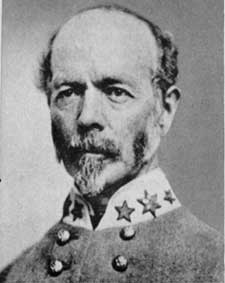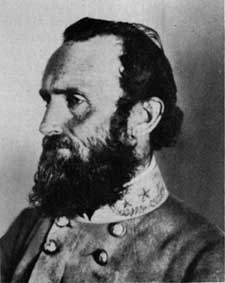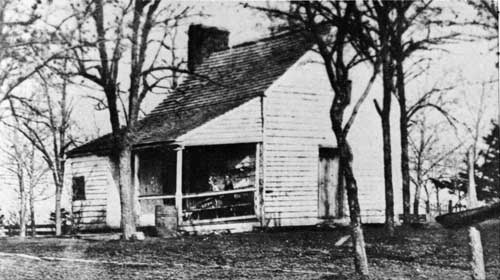|
MANASSAS National Battlefield Park |
 |
First Battle of Manassas
 Gen. Joseph E. Johnston in command of the Army of the Shenandoah. Courtesy National Archives. |
 Brig. Gen. Thomas J. "Stonewall" Jackson. Courtesy National Archives. |
AFTERNOON PHASE. About 2 p. m., McDowell ordered forward the two splendid, regular batteries of Ricketts and Griffin, directing them to take up an exposed position just south of the Henry House. At a distance of not much more than 300 yards, these batteries were soon engaged in a furious duel with the artillery arrayed in Jackson's front. For about 15 minutes the din was terrific. Finally, in an effort to gain a better enfilading fire, Griffin advanced three of his guns slightly. The movement proved fatal.
At this moment E. B. Stuart made a dashing cavalry charge up the Manassas-Sudley Road, scattering the colorful Fire Zouaves who had been advanced to the support of Ricketts and Griffin. Almost simultaneously the 33rd Virginia regiment moved forward. Mistaken by one of the Federal officers as a battery support, it was allowed to come within 70 yards of Griffin's guns. Suddenly the regiment delivered a murderous volley, which killed most of the horses and men of both batteries. The immobilized guns were seized by the Virginians, only to be recaptured by a spirited Federal advance. In heated charges and countercharges the guns changed hands a number of times, yet neither side was able to employ them effectively. Their loss to the Federal command was irreparable.
Federal pressure now became so strong that Beauregard decided to attack. As Jackson penetrated the center of the Federal line, the Confederate right swept clear the area in the vicinity of the Robinson House. In a gallant countercharge however, the Union brigades of Franklin, Willcox, Sherman, and Porter surged forward to reclaim the lost ground. In the attack, McDowell displayed reckless courage by climbing to the upper story of the Henry House to obtain a better view of the whole field.

The Robinson House.
From a wartime photograph
in "Photographic History of the Civil War."
The battle now raged with increasing severity as both sides fought desperately for possession of the plateau—"the key to victory." The weight of Federal pressure upon Beauregard's left and right flanks so increased as to endanger his whole position. It was now about 3 p. m. The scorching rays of the sun beat unmercifully upon the exhausted troops as Beauregard, at this critical stage, ordered yet another general attack all along the line. Just then Fisher's 6th North Carolina regiment arrived to take position on the Confederate left. With Beauregard leading the charge, the Confederate line advanced to clear the field and regain final possession of the Henry and Robinson Houses.
Despite the loss of the plateau, McDowell's position was still strong. With his right anchored in the woods in the vicinity of the Chinn House, his line stretched in a great crescent back of the Stone House to a position near the Stone Bridge. However, the right held by Howard's brigade and Sykes' regulars had become so extended as to face almost east towards Centreville. Thus extended, it invited an attack which the Confederate command was quick to mount. Reinforcements, sent forward by Johnston, now rapidly moved up. In the lead were Kershaw's 2d and Cash's 8th South Carolina regiments followed by Kemper's battery. Quickly following these troops came Elzey's brigade, 1,700 strong. This brigade of Johnston's Army, detrained only a few hours before, had advanced to the sound of firing, led by Kirby Smith. To the weight of these numbers was added still another fresh brigade— Early's. Coming into position to the left of Elzey's brigade, Early struck the Federal right in flank and rear.
The combined attack, delivered about 3:45 p. m., proved overwhelming. The Federal line staggered and fell back, retiring across the field in some semblance of order. A brief rally north of Young's Branch was broken up by Confederate artillery fire. All other attempts to rally the men proved futile. They had had enough. Now they continued homeward by the various routes of the morning's advance. Bravely covering the retreat were Sykes' regulars and Palmer's squadron of cavalry.
As the main body of the Federal army retreated in the direction of Sudley Ford, Keyes' brigade recrossed at the Stone Bridge closely pursued by a Confederate detachment led by Kemper's battery. Riding astraddle one of the guns was the venerable "Yankee hater," Edmund Ruffin, who had fired one of the first shots at Fort Sumter. Dusty and weary he had arrived upon the field in the closing moments of the battle in time to hail Kemper's battery as it was passing. Eager to get another shot at the enemy, he held precariously to his seat as the battery went jolting past the Stone Bridge and along the pike now littered with arms accoutrements, haversacks, knapsacks, loose articles of clothing, blankets, drums, and brass musical instruments left by the rapidly retiring troops.
After proceeding a few miles, Kemper's guns reached an advantageous rise. There they were unlimbered and quickly made ready for firing. The first shot, fired by the elderly Ruffin, hit squarely upon the suspension bridge over Cub Run upsetting a wagon that had just been driven upon it. This served to barricade the bridge to further use by other vehicles. In quick succession more shots were fired. Complete panic now seized the Federal troops as they fled in a wild rout back to Washington. Adding to the confusion were the throngs of sightseers and fugitives who crowded the narrow roads. The roar of the flight, wrote Russell, The London Times' correspondent, was like the rush of a great river. All through the night and the rain of the next day the tide of soldiers and civilians streamed into Washington. Attempts by McDowell to rally the soldiers were in vain.
The exhausted, battle-weary Confederates made no effective pursuit. Early's brigade and Stuart's cavalry did succeed in capturing quite a number of prisoners, but the main Union force escaped. July 22 found both armies in the positions they had occupied prior to the 16th.

|

|
|
Last Modified: Sat, Apr 7 2001 10:00:00 am PDT |


